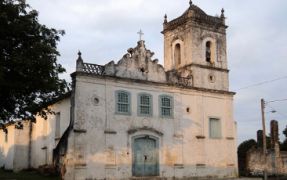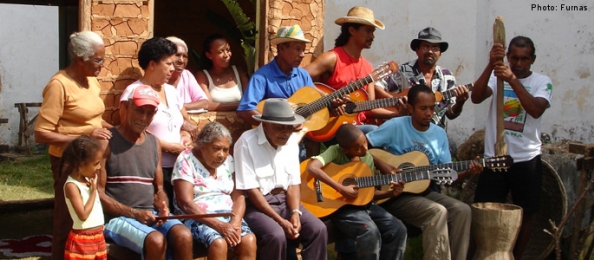Community Development and Sustainability
Since its founding in 1957, FURNAS has been working toward the development of Brazilian society by generating and transmitting electrical energy. Today, the company runs a complex of 15 hydroelectric power plants, two thermal units, and a transmission system responsible for 40 percent of the electrical energy consumed in Brazil. As a participant in the Global Compact, the company promotes activities for the sustainable development of the communities in the vicinities of its installations, upholding the Ten Principles of the Global Compact.
The company and social responsibility
FURNAS is a member of the Committee of Entities in the Fight against Hunger and for Life (COEP), a human and social development network. Our social responsibility policy expresses the company’s commitment to rallying our stakeholders toward a fair society, in harmony with nature, based on sustainability and solidarity.
Key Facts
| Initiator | Eletrobras Furnas |
| Project start | 2005 |
| Status | ongoing |
| Region | Brazil |
| Contact person | Claudia Rodrigues Segond |
| Awards |
Project benefit
- Establishing opportunities for unemployed
- Strengthening of social communities
- Inteegration of minorities
Main Issue
| Anti-Corruption | - |
| Business & Peace | - |
| Development | X |
| Environment | - |
| Financial Markets | - |
| Implementing UNGC Principles in your Corporate CSR Management | - |
| Human Rights | X |
| Labour Standards | - |
| Local Networks | - |
Project Type
| Advocacy of global issues | - |
| Business opportunities in low income communities/countries | - |
| Project funding | X |
| Provision of goods | - |
| Provision of services/personal | - |
| Standards and guidelines development | - |
Partner
Together with COEP, the Brazilian Institute of Social and Economic Analysis (IBASE – Instituto Brasileiro de Análises Sociais e Econômicas) developed a methodology to keep an open, ongoing dialog with communities to integrate local actors in the process of territorial sustainable development. As businesses expand, FURNAS has implemented the socalled Integration Nucleus Project, whose principle is to establish a democratic governance culture that seeks to integrate diverse social groups, local institutions, and government agencies to strengthen community bounds – a mandatory condition for local sustainable development. Communities are chosen based on their social, environmental, and cultural aspects, and preference is given to traditional and low-income social groups. Sixteen Integration Nuclei have been implemented so far, benefitting around 35,000 people in the states of Rio de Janeiro, Minas Gerais, Espírito Santo, Mato Grosso, and Goiás. This project has shown itself to be not only a social catalyst and local sustainable development facilitating tool, but also an important corporate management tool. Experience acquired in every new social context is gradually internalized, thereby improving governance tools and dialog with communities. The descendants of the former slave community (or Quilombo) of Araçatiba – in the project since 2005 – illustrate the success of the Integration Nucleus Project.
Housed in the municipality of Viana in the state of Espírito Santo were around 200 families, representing nearly 800 people, in the 2010 census. This community came about when Spanish Jesuits founded the Araçatiba farm, raised the Nossa Senhora da Ajuda Church in 1665, and christened the native Brazilian Tupiniquins, the original dwellers, enslaving them to work in sugar cane plantations.
After the Portuguese crown expelled the Spanish army, the native Brazilians living there fled, leaving the place empty. In 1849, Sebastião Vieira Machado, the farm’s new administrator, brought 800 slaves from Africa to toil on Brazilian land. After slavery was abolished, the former slaves did not leave the area. To guarantee these former slaves a place to live, Sebastião’s children donated both the Nossa Senhora da Ajuda Church and an adjacent 21-hectare piece of land to the Vitória Archdiocese. As years passed, though, new farmers settled in the area, taking 16 of the 21 hectares donated to protect the former slaves. Today, most of the population works in the capital city of Espírito Santo. Local business is quite limited and prices are steep, so families are forced to buy outside of the community.

Photo: Furnas
During the project implementation, the main problems raised were:
Lack of work opportunities and daycare; poor communication between local dwellers; quilombolas and other communities; weak community bonds; lack of communal areas; need to reform the Nossa Senhora da Ajuda Church and build a burial chapel; no professional courses and work for the young; high rate of drug use; no funding for maintaining Congo costumes for a folk group with indigenous and slave influence.
Results of the Integration Nucleus Project
The Araçatiba Telecenter (2006) did research on the local history and produced a video entitled “A Land of Slave Descendents and the Saint’s Heritage” in association with Espírito Santo Federal University. The similarly titled book was produced in association with IBASE (2007) and offered in conjunction with a number of workshops: social cartography to identify quilombola territories; production of Bandas de Congo musical instruments; and local culinary presentations. Courses on the Linux operational system and introduction to IT were offered by the National Service of Commerce. Education for cooperativism, seamstressing, embroidery, patchwork, and gemworks was given in cooperation with COEP. The workshop CosturArt was offered, wherein women learned craftwork, typical dishes, and the young learned hair-braiding, the events of a solidarity economy, and how to market craftwork (2008). There were meetings with local government representatives to streamline social demands as well as meetings with other communities to implement Espírito Santo Quilombola Community Identity Strengthening Program, which represents the legal process for acknowledging the land deeds of these communities (2010). There were also celebrations with Banda de Congo, folk dances, and fashion shows to market clothes made at the workshop Costur- Art, thus helping to integrate the young, adults, and the old, and strengthen the community’s identity (2011).
Claudia Rodrigues Segond works for Eletrobras Furnas.
Furnas is a mixed economy company that generates and transmits electricity, a subsidiary of Centrais Elétricas Brasileiras S.A. - Eletrobras, associated with the Ministry of Mines and Energy.
Background
Furnas was created in the middle of the 1950s to address the emerging energy crisis which threatened supplies to Brazil's three main social and economic centers – São Paulo, Rio de Janeiro and Belo Horizonte.
The company Central Elétrica de Furnas was created on February 28, 1957, via Federal Decree 41,066 in order to build and operate Brazil's first large-scale hydroelectric plant, the Furnas Hydroelectric Plant, with an output of 1216 MW, on the Río Grande river. The company, which was based in Passos (MG), began operating in 1963.
The company
Furnas is based in Rio de Janeiro (RJ) with branches in Minas Gerais, Goiás, Mato Grosso, Espírito Santo, Federal District, Tocantins, Paraná, Rio Grande do Sul, Santa Catarina, Rondônia, São Paulo and most recently Rio Grande do Norte.
Furnas runs a range of enterprises which generate 10% of Brazil's electricity. These enterprises include 17 hydroelectric power stations, 2 thermal power stations, approximately 24,000 km of transmission lines and 62 substations. 40% of all of the energy consumed in Brazil passes through the Eletrobras Furnas System. The company is responsible for supplying energy to an area accounting for 63% of Brazilian homes and 81% of domestic GDP.
The company is responsible for supplying energy to an area accounting for 63% of Brazilian homes and 81% of domestic GDP.
Today, the company is implementing an expansion plan and is building 4 new hydroelectric power stations – Santo Antonio (RO), Simplício (RJ/MG), Batalha (GO/MG) and Teles Pires (MT/PA) - 28 transmission lines and 15 substations, funded by the company itself or in partnership with other companies. All of these projects create thousands of jobs and will bring electricity to over 13 million Brazilians, bringing the number of people who receive energy generated or transmitted under the Furnas brand to 41 million. Generating capacity will increase by more than 50%, from 11,000 MW to 16.5 thousand megawatts.
Furnas is not only involved in hydroelectric and thermal power generation, it also invests in alternative energy sources. Partnering with other business groups, it holds authorization to build 30 wind farms in Ceará and Rio Grande do Norte with a total output of 750 MW.
Mission
To act with the highest standards of business excellence and social and environmental responsibility in the electricity industry, contributing towards society's development.
Source: fumas.com.br
Write a comment about this page
Your comments are provided by your own free will and you take sole responsibility for any direct or indirect liability. In order to maintain the highest discussion quality, all comments will be reviewed by our editors. You hereby provide us with an irrevocable, unlimited, and global license for no consideration to use, reuse, delete or publish comments in accordance with our Community Guidelines.


